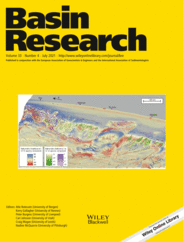
Full text loading...
 , Andong Zhang1, Chengfa Lin1, Bo Zhang1, Haotian Yuan1, Diying Huang2,3, Ronald J. Steel4, Brian K. Horton4,5
, Andong Zhang1, Chengfa Lin1, Bo Zhang1, Haotian Yuan1, Diying Huang2,3, Ronald J. Steel4, Brian K. Horton4,5
The Late Triassic Chapeng thrust and the Dengzhangzi Basin system in the Yanshan Mountains of the North China Craton were an antiformal stack duplex with a frontal depression.
The configuration and kinematics of fold‐thrust belts are essential for clarifying the plate boundary conditions through which ancient orogenic belts evolved. Temporal and spatial variations in extension versus contraction within convergent plate margins are related to changes in plate kinematics and subduction geometry. The Yanshan Mountains, located along the northeastern margin of the North China Craton and bounded by the Central Asian Orogenic Belt to the north and the Pacific subduction zone to the east, underwent multiple phases of intra‐continental deformation during the Mesozoic. The issue of whether early Mesozoic deformation was extensional or contractional has remained controversial. New regional structural mapping and detailed sedimentological investigations, coupled with age constraints provided by zircon U‐Pb geochronology, provide sufficient temporal and spatial resolution to show that shortening and thrust‐top basin systems dominated during the early Mesozoic. Our results show that the Dengzhangzi Basin within the Lingyuan fold‐thrust belt developed during the construction of a major Late Triassic Chapeng antiformal‐stack duplex system, with episodic, east‐vergent forward‐breaking thrusts and subsequent ‘beheading’ by out‐of‐sequence, top‐to‐east thrusting in the latest Triassic or earliest Jurassic. The neighbouring Guojiadian Basin in the east was generated during top‐to‐SSE sinistral transpression along the Niuyingzi thrust system in the Middle to earliest Late Jurassic. These results support a new model of early craton decratonization involving (a) thrusting along the northern margin of the North China Craton and (b) transpressional deformation in the east driven by the Central Asian Ocean collision and flat‐slab subduction of the Palaeo‐Pacific Plate beneath the East Asian continental margin. Our findings suggest that large‐scale shortening and crustal/lithospheric thickening, triggered by flat‐slab subduction in the North China Craton, were fundamental components of craton decratonization. Subsequent slab roll‐back during the Cretaceous led to lithospheric thinning and crustal extension in the North China Craton.
]
Article metrics loading...

Full text loading...
References


Data & Media loading...

